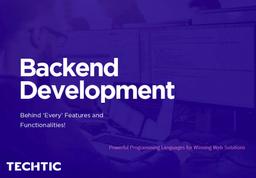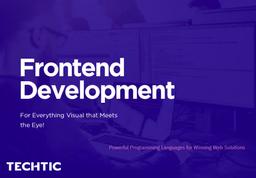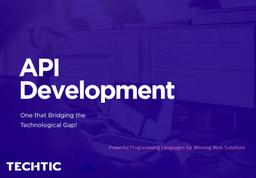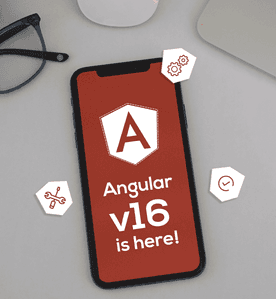Difference between Front End and Back End Development
Sector: Technology
Author: Hemant Kumar
Date Published: 10/01/2019

Contents
So, you want to get started with developing a web application? While web app development is as rewarding as rewarding can get, it can get tricky when the right tools, techniques are not applied. With the evolution of new programming languages, frameworks and evolving libraries, there is no dearth of choice for developers.
The devil lies in the details though. Because websites are more than just HTML and CSS. To cut a long story short, web development can be broadly split into two major parts:
- Frontend Development –Code that runs in the web browser
- Backend Development –Code that runs on the server
In simple terms, frontend is for the end users and backend is for developers (or system administrators) who keep a tab on the web app and troubleshoot issues. These two are often considered to be separate entities, although these are often closely connected and need to work hand-in-hand in most of the web development projects.
We at Techtic Solutions have been harnessing the programming languages that provide a level-playing field for various developers in both backend and frontend development. In this article, we’ll explore some of the most common programming languages used for web application development and how Techtic is using them to their full potential to build awesome web and mobile applications.
Backend Development – Behind ‘Every’ Features and Functionalities

Creating the backend can be a daunting task. This is mainly due to the fact that the results of the coding done, is not immediately visible. The core tasks in backend include creating a server, setting up the routing, connecting to a database and the likes.
Backend development makes use of the command line prompts, which is not exactly a cakewalk. Techtic understands this and brings on board, highly-skilled and experienced backend developers. They are certified in using the right technology stack, which is a crucial component when it comes to scalability.
The backend development from our doorstep is delivered using the best tools and technologies. Most of them have a wide range of libraries, are maintainable and scalable and most importantly, enjoy tremendous community support. Here are a few popular and efficient technologies that our team of backend developers use.
1. NodeJS
Node.js is an asynchronous JavaScript runtime and is built on Chrome’s V8 JavaScript engine. Used for building scalable network applications, it can concurrently handle several connections at one go. One of the mainstays of this technology is that there are no locks.
Moreover, no function in Node.js can directly perform I/O. This is why the process can never block. The result? We are able to build highly scalable systems for our clients as they can be best developed in Node.js.
2. Laravel
Labeled as ‘the PHP framework for web artisans’, Laravel is a web application framework known for its extremely elegant syntax. The makers of Laravel believe in making development an enjoyable process and tilt more towards the creative side. At Techtic, we use this technology with the aim of making development hassle-free. It helps in easing the common tasks that are used in many web projects.
3. Python
When developers want to integrate systems more quickly, Python is the programming language that they need to opt for. What we like about it is its Package Index, which consists of third-party modules for Python. Additionally, it also offers several choices for web development, including frameworks (Django and Pyramid), advanced content management systems, micro-frameworks and so on and so forth. An easy-to-use socket interface and multiple libraries make it a favorite with the developers.
4. Ruby on Rails
Ruby on Rails, commonly called ROR is a must-have tool in every developer’s kitty for developing outstanding applications. Derived from a couple of other coding languages, including Python, it has been used for some of the most well-known brands such as Basecamp, GitHub and Airbnb. The open source software has a clear syntax and is based on the tenets of – optimizing for programmer happiness with Convention over Configuration.
Frontend Development – For Everything that Meets the Eye

When you think of frontend, think of the immediate visual feedback users get when they open a web app on their browsers. It includes both UI and UX considerations. HTML and CSS are the basic programming languages to develop frontend of a website. But to maintain it and add more features and functionalities, it needs some advanced techniques.
At Techtic, we focus on using the best Frontend development stack and leave no stones unturned to ensure an enhanced user experience. We completely rely on our team of full-stack developersto select the apt technology and work on creating a seamless experience across all our web development projects.
1. AngularJS
The Angular Js technology allows developers to build apps and reuse the code for various other forms of deployment. Ergo, the responsive framework helps code just one time and develop for the web, native mobile, mobile web and native desktop.
This technology makes it possible for our developers to achieve both speed and performance, meets huge data requirements and builds features quickly with its amazing templates. Also, the main benefit of Angular is that it offers an outstanding infrastructure to support Google’s largest applications.
2. ReactJS
User Interfaces are crucial in any web application and React makes it a breeze to create some of the most interactive UIs. The declarative views offered renders the code predictable and is easy to debug. Since it is component-based, rich data can be passed through the app. As far as the new features are concerned, it is favorite with React js developers as it is easy to develop them without having to rewrite the existing code. But the best part is that React lets developers’ interface with other libraries and frameworks.
3. Gatsby
Gatsby is a free and open source framework, known for being a fast-modern site and apps generator for React. The salient features of Gatsby include pulling data from anywhere, using a variety of data sources, CMSs, Markdowns and so on and so forth.
4. HTML5
HTML5 is the latest version of HTML and can be used to develop various cross-platform applications. The technologies used in HTML5 offer several functionalities including topnotch semantics, better connectivity, offline and storage, multimedia options, 2D/3D graphics and effects, and amazing performance and integration. It is largely favored by developers as it allows sophisticated themes and the use of a number of input and output devices.
API – Bridging the Technological Gap

API or Application Programming Interface ties the loose threads and acts as a bridge between the frontend and backend development. Without an API, software can’t function the way they should. This is because they provide access to the data. By using the best API tool, it is easier to break out of the trial and error cycle for the details. Moreover, it also leads to reduction of the task size and automates a lot of functionalities. This eases the tasks for the developers.
We at Techtic, pick and choose the right API technology to make sure that any communication that takes place is seamless, quick and enhances the project performance manifold.
1. GraphQL
GraphQL offers developers a query language for APIs along with a runtime for fulfilling those queries with an existing data. APIs can easily evolve and enable some of the most powerful developer tools. What makes this stand apart is that it returns exactly what is asked for, i.e. predictable results.
At the end of the day, it allows the creation of fast and stable apps due to better control over the data and not the server. It is a great asset to our development team at Techtic, when we require building apps that can function quickly even with slow mobile internet connections. Moreover, new fields and types can be added to a GraphQL API without impacting any of the existing queries.
2. Lumen
Minimalism is the order of the day for many applications and making it possible is Lumen – a fast micro-framework by Laravel. It is known for offering some of the fastest micro-services and the APIs. For developing fastest services for supporting the Laravel applications, Lumen is definitely the way to go.
It offers the convenience of using Laravel features including Eloquent, middleware, validation, service container, caching, etc. with almost no configuration. But the best part is that it can be upgraded to the full-fledged Laravel framework by using the code in a Laravel installation. The rest is simple.
3. REST
REST or REpresentational State transfer is an architectural style for distributed hypermedia systems and includes 6 guiding constraints. REST allows the separation of user interface concerns from the data storage concerns.
It is a great asset for developers as it keeps session state entirely on the client-side, is cacheable, offers a uniform interface, has a layered system, and provides the option of coding on demand. It also uses a resource identifier to identify a specific resource that is involved in an interaction between components. REST also includes resource methods for any desired transition.
Over to you…
Techtic likes to stay ahead and aims to cover all the nuances of web development under the same roof. Our team of expert full stack developers pay attention to detail and painstakingly create spectacular websites that can help your business or brand propel forward. Meticulous in their work, they know the in and out of all the programming languages required for frontend, backend and API. This is the reason we are able to churn out some of the top web apps from our doorstep for our clients.
Interested in knowing more? Schedule a call today!
Latest Tech Insights!
Join our newsletter for the latest updates, tips, and trends.



